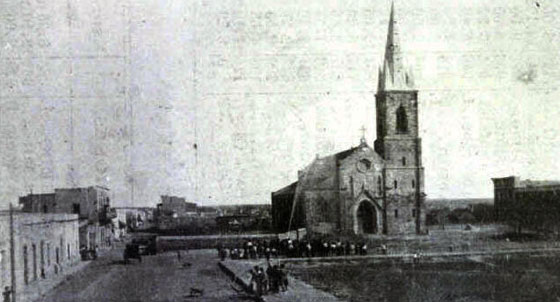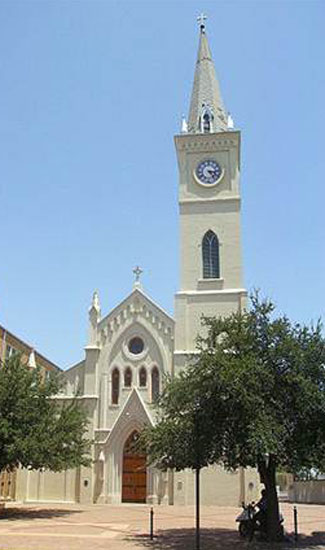St. Augustine Plaza, Laredo
St. Augustine Plaza is at the heart of a historic community established in 1755. In addition to the six flags that flew over Texas, Laredo had a seventh flag representing the Republic of the Rio Grande, an unsuccessful attempt to break with the Republic of Mexico in 1840. The capital of the Republic of the Rio Grande has been established as a museum and can be visited today on the south side of the plaza. During the Civil War, St. Augustine's was a beehive of activity after Confederate officer Col. Santos Benavides established his headquarters here. Benavides' original home, along with that of his brother-in-law, John Z. Leyendecker, can be seen on the west side of the plaza. Most Confederate troops were garrisoned in buildings on or near the plaza for much of the war. Laredo became particularly important when cotton moved across the river, especially after the federal occupation of the Lower Rio Grande Valley in late 1863 and early 1864. For the citizens of Laredo these were the “cotton times.” Union forces attempted to destroy five thousand bales of cotton stacked in the plaza when they attacked the town in March 1864. Benavides and his men barricaded the streets with cotton bales and placed snipers on the buildings around the plaza. Although St. Augustine's was largely treeless at the time, Benavides did manage to hang two horse thieves here during the war. A historical marker honoring the Benavides brothers, Santos, Refugio, and Cristobal, can be seen on the plaza today.
Listen
La Plaza de San Agustín se encuentra en el mismo centro del histórico asentamiento establecido en 1755. Además de las seis banderas nacionales que ondearon sobre el territorio de Texas, Laredo tuvo una séptima, en representación de la República del Río Grande, un intento frustrado de independizarse de la República de México en 1840. La capital de la República del Río Grande se conservó en forma de un museo que puede visitarse en la actualidad en el extremo meridional de la plaza. Durante la Guerra de Secesión, San Agustín era un hormiguero de actividad después de que el coronel Santos Benavides estableciera allí su cuartel general. La residencia original de Benavides, junto con la de su cuñado John Z. Leyendecker, puede contemplarse en el lado occidental de la plaza. La mayor parte de las tropas confederadas se encontraban acuarteladas en edificios linderos con la plaza, o cercanos a ella, durante la mayor parte de la duración de la guerra. Laredo adquirió una importancia especial cuando el comercio del algodón empezó a discurrir por el río, sobre todo después de la ocupación federal de El Valle del bajo Río Grande, de finales de 1863 a mediados de 1864: fue una auténtica «época algodonada» para los habitantes. Las fuerzas de la Unión, no obstante, intentaron destruir cinco mil balas de algodón que se encontraban apiladas en la plaza cuando asaltaron la ciudad en marzo de 1864, pero Benavides y sus hombres levantaron barricadas en las calles precisamente con las mismas balas de algodón y emplazaron francotiradores en los edificios circundantes. Aunque, en aquella época, la Plaza de San Agustín carecía en su mayor parte de árboles, Benavides se las arregló para ajusticiar en la horca a dos ladrones de caballos durante la guerra. En la actualidad puede observarse en la plaza una placa en honor de los tres hermanos Benavides: Santos, Refugio y Cristóbal.
Escucha
Details
Location: 201 St. Augustine St., Webb County
Access: 24 hour public access.
GPS Coordinates
Photos

San Agustín Roman Catholic church was
originally founded in 1760 during the
Spanish regime. The original church
fell into disrepair and was reconstructed,
at the same time as Fort MacIntosh,
between 1866 and 1872. This photograph
of the Gothic Revival brick edifice shows
it unpainted, without its clock, and with
some differences in its steeple.
Webb County Heritage Foundation
Foundation, Laredo, Texas

